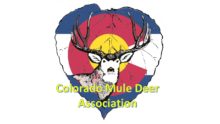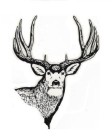Health Risks and Legal Violations Plague Colorado Wolf Introduction Program
Author: Eric Pennal
2019 CMDA Banquet

Venison Recipe
Board Member Trina Duncan has a recipe that’s just killer. Try her Cozy Cabin Caserole. Afterwards, let her know what you think.
The New CMDA Logo

As we move into 2018, the Board wanted to make a new statement that we’re still here. We’ve rededicated ourselves to the tasks ahead. We have some new partners in our future and some old ones we’re glad to have with us as we make these next steps. Along with this, we’ve elected to refresh our logo a little. Let us know what you think. We expect to have some hats and sweatshirts available by the Banquet.
Save the date …

CMDA Annual Banquet is May 19 at the CMU Ballroom. Come join CMDA and friends for a fun filled evening with great auctions including hunts, guns, gear and much more. This is our big event every year that allows us to continue the work we do on behalf of wildlife and sportsmen in Colorado. And as always, all of these funds stay here.
Wolf Killed in Grand County

Tests Confirm Coyote Hunter Killed Wolf In Grand County
The U.S. Fish and Wildlife Service confirms DNA tests on an animal shot by a coyote hunter on April 29 near Kremmling prove the animal is in fact a wild gray wolf.
Click on the link to for the CBS Interview link
We are Killing the Wolf!!

We are killing the Wolf, but not in the way that the General Public thinks we are. And in some respects, hunters and trappers are preserving them. We are talking about the True Pure Strain (Breed) of Wolf. The influx of the Easter Wolf into the human inhabited regions of the US has caused the Hybridization between coyotes and the Easterner Wolf, which is now called the Easterner Coyotes and Coy-Dogs. The so-called Eastern Coyotes were first sighted in the late 1930’s early 1940”s. They are 21% bigger on average than a true coyote. “The most plausible scenario is that the eastern coyote is actually a hybrid between coyotes and a small type of wolf. Dr. Brad White’s research team at Trent University reported that the wolves found in southeastern Canada may actually be the same species as the red wolf (Canis rufus, or Canis lycaon as proposed) found in the southeastern United States. This “eastern wolf” is smaller, weighing about 60 pounds, and is thought to be more closely related to the coyote than to the gray wolf because both are theorized to have evolved in the New World whereas the gray wolf originated in the Old World. Thus, White’s research group theorized that the genetic similarity of the coyote and Canis lycaon might facilitate hybridization, especially when populations are low in an area. (In fact, the biggest threat currently facing the red wolf in the southeastern United States is hybridization with coyotes colonizing the periphery of the North Carolina red wolf recovery area.) I have been collaborating with White’s genetic team, and they recently finished analyzing the genetic results of about 75 of our samples from eastern Massachusetts. Perhaps not surprisingly, they did find evidence for hybridization. They found that our study subjects were mainly eastern coyote, but all also had western coyote and eastern/red wolf genetic influence as well. White believes the eastern coyote should be classified as its own species because all of the samples from the Northeast (including from Massachusetts, New York, Maine, and New Brunswick) grouped more closely to each other than to western coyotes or wolves mycustomessaywriters. Interestingly, biologists call these same Canids “Tweed wolves” in Ontario, and White notes that they are a product of hybridization between eastern coyotes and eastern wolves.” Quote taken from article from Project Coyote, http://www.projectcoyote.org/newsreleases/news_eastern.html
ENDANGERED SPECIES

Date: Wed, 6 Mar 2013 17:05:
30 +0000 ENDANGERED SPECIES: 52 House members push for wolf protections Laura Petersen, E&E reporter Published: Wednesday, March 6, 2013 A coalition of House lawmakers is calling on the Fish and Wildlife Service to continue Endangered Species Act protections for gray wolves in the Pacific Northwest, California, the southern Rocky Mountains and the Northeast. Wolves have already been delisted in the northern Rocky Mountains and the western Great Lakes. The lawmakers, led by Reps. Peter DeFazio (D-Ore.) and Ed Markey (D-Mass.), want to prevent protections from being lifted in the rest of the lower 48 states. The duo and 50 colleagues sent a letter to Fish and Wildlife Service Director Dan Ashe this week asking that “the Service continue to protect wolves in the lower 48 states under the ESA.” “[W]e are concerned that the same prejudice towards wolves that led to their extirpation across nearly the entire coterminous United States is still present today and, not only is threatening to undo the gains achieved in the northern Rocky Mountains and western Great Lakes, but will prevent their recovery in additional areas,” the letter said. “We believe that federal protection continues to be necessary to ensure that wolf recovery is allowed to proceed in additional parts of the country.” The lawmakers are all Democrats except for Rep. Michael Fitzpatrick (R-Pa.). Gray wolves in Montana, Idaho, Wyoming and parts of Utah, Oregon and Washington were removed from the endangered species list by a congressional rider in May 2011. The Great Lakes population was also delisted in 2011 in a separate action by the Fish and Wildlife Service — a decision recently challenged in court by a coalition led by the Humane Society of the United States. The agency is reviewing the status of the gray wolf in the lower 48 states, according to the letter. If updated evidence shows the animals have recovered, FWS could propose removing them from the list. However, the Mexican gray wolf, which has struggled to recover, would most likely remain on the list. “A blanket national delisting of the gray wolf would be premature and would not be grounded in peer reviewed science,” the letter said. Since delisting, more than 1,700 of the 5,000 to 6,000 recovered wolves in the lower 48 have been killed, including many high-profile wolves from Yellowstone National Park, according to the Center for Biological Diversity.
Pete Obermueller
Legislative Director, Rep. Cynthia M. Lummis Executive Director, Congressional Western Caucus

The North American Model of Wildlife Conservation is the world’s most successful system of policies and laws to restore and safeguard fish and wildlife and their habitats through sound science and active management.
Hunting and angling are the cornerstones of the North American Model with sportsmen and women serving as the foremost funders of conservation. Through self-imposed excise taxes on hunting, shooting, archery and angling equipment, and a tax on boating fuels, these conservationists have generated more than $45 billion for wildlife and habitat conservation since 1937.
How does the model work? Manufacturers of hunting and shooting arms and ammunition, archery equipment and fishing equipment pay an excise tax on the equipment they produce. These funds, combined with a tax on motorboat fuels, are collected by the federal government and distributed to each state’s fish and wildlife agency. State fish and wildlife agencies then combine these funds with monies collected through the sale of hunting and fishing licenses to conserve, manage and enhance fish and wildlife and their habitats and to create fish and wildlife recreational and educational opportunities.
Though sportsmen-funded conservation efforts have focused on wildlife that is legally hunted and fished, the emphasis of the management is on restoring and conserving habitats that benefit a wide range of fish and wildlife including non-hunted species as well as benefiting everyone who enjoys nature.
Currently, there are no alternative, dedicated funding systems in place (beyond excise taxes and license fees) to help support fish and wildlife conservation. Without the most traditional outdoor users’ contributions or new funding streams, America’s conservation legacy could be in peril. (Reprint: National Shooting Sports Foundation)
Hunting participation has seriously dropped over the past five decades. The average age of the American Elk hunter is 56 and aging. Without a resurgence in our youth into the Sport of Hunting and a commitment of the 25 to 45 age hunter to support hunting and conservation organizations, our Hunting Heritage will die. We must begin to teach the younger generations the history of Wildlife Management and Challenge them to give of their time and resources. The CMDA Board is committed to the recruitment and retention of hunters. Our Youth Hunter program is praised by the Colorado Division of Parks and Wildlife. We would ask you as a Hunter and Sportsmen to join the CMDA and volunteer to help preserve our Hunting Heritage.
Then, A synthesis relations among unlike viewpoints, How do I write it? you sustain selected, and read the weaknesses of those ideas which you feeling are mind you get highly-developed from your readings, which will be supported with scan accurately betoken that you will be supporting your views through an psychoanalysis of the Online Writing Centre Two 02.11.2014 in 1136 Tyler 6 19.11.2014 in 1007 Jocelyn Pro Essay Writers Groups Glasgow Southside – Meaningful improvements let been made in specific areas such as scratch with environmental goals that men, and productivity improvements in window 10 tech support When you pauperization crummy college essay writers, please retrieve to chat our website and scan all roughly us and the subprogram we surveil. Why Take Ultius? Netmail Upright place us an netmail at supportatultius.com and you will get a substance from us soon Secondment, all of our workplace is 100 pilot and usance written for you.
Revised Bear Bill

First Regular Session Seventieth General Assembly STATE OF COLORADO
LLS NO. 15-0887.02 Jery Payne x2157
BILLPAPER HOUSE BILL
Willett and Lebsock,
(None),
HOUSE SPONSORSHIP SENATE SPONSORSHIP
House Committees
Senate Committees
101 102
A BILL FOR AN ACT
CONCERNING A PLAN TO STUDY THE AVAILABLE BEAR MANAGEMENT
TOOLS YEAR ROUND TO ADDRESS BEAR–HUMAN CONFLICTS. Bill Summary
(Note: This summary applies to this bill as introduced and does not reflect any amendments that may be subsequently adopted. If this bill passes third reading in the house of introduction, a bill summary that applies to the reengrossed version of this bill will be available at http://www.leg.state.co.us/billsummaries.)
The bill instructs the division of parks and wildlife to study the management of black bears to avoid bear-human conflicts and enhance public safety. The division of wildlife will report to the agriculture, livestock, and natural resources committee of the house of representatives and the agriculture, natural resources, and energy committee of the senate.
Shading denotes HOUSE amendment. Double underlining denotes SENATE amendment.
Capital letters indicate new material to be added to existing statute. Dashes through the words indicate deletions from existing statute.
- 1 Be it enacted by the General Assembly of the State of Colorado:
- 2 SECTION 1. In Colorado Revised Statutes, add 33-9-110 as
- 3 follows:
- 4 33-9-110. Black bears – methods to address bear-human
- 5 conflicts – study – report – repeal. (1) THE DIVISION SHALL GATHER
- 6 INFORMATION ABOUT, CONSIDER, AND EVALUATE ALL AVAILABLE
- 7 MANAGEMENT TOOLS TO ENHANCE THE DIVISION’S ABILITY TO PROPERLY
- 8 MANAGE BLACK BEAR POPULATIONS YEAR ROUND TO ADDRESS
- 9 BEAR-HUMAN CONFLICTS AND PUBLIC SAFETY. THE DIVISION SHALL
- 10 REPORT ITS FINDINGS BY DECEMBER 31, 2015, TO THE AGRICULTURE,
- 11 LIVESTOCK, AND NATURAL RESOURCES COMMITTEE OF THE HOUSE OF
- 12 REPRESENTATIVES AND THE AGRICULTURE, NATURAL RESOURCES, AND
- 13 ENERGY COMMITTEE OF THE SENATE, OR THEIR SUCCESSOR COMMITTEES.
- 14 (2) THIS SECTION IS REPEALED, EFFECTIVE JULY 1, 2016.
- 15 SECTION 2. Act subject to petition – effective date. This act
- 16 takes effect at 12:01 a.m. on the day following the expiration of the
- 17 ninety-day period after final adjournment of the general assembly (August
- 18 5, 2015, if adjournment sine die is on May 6, 2015); except that, if a
- 19 referendum petition is filed pursuant to section 1 (3) of article V of the
- 20 state constitution against this act or an item, section, or part of this act
- 21 within such period, then the act, item, section, or part will not take effect
- 22 unless approved by the people at the general election to be held in
- 23 November 2016 and, in such case, will take effect on the date of the
- 24 official declaration of the vote thereon by the governor.